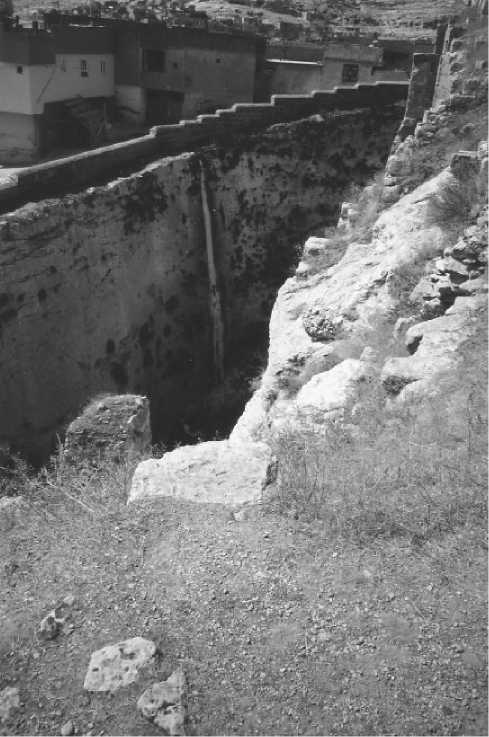Edessa (mod. fianliurfa, Turkey) was the principal city of the Frankish county of Edessa from 1098 until its capture by the Muslims in 1144. In the medieval period it was also variously known as Ourha (Armenian), al-Ruha’ (Arabic), Orhay (Syriac), and Rohas (Latin).
Edessa was founded by the Seleucid dynasty of Syria in the third century b. c. and had a significant Christian population by the early third century a. d. For Christians of the late antique and medieval periods, the city was inseparably linked to the apocryphal letters exchanged between Jesus and King Abgar V. Edessa became part of the Roman Empire in the mid-third century and soon became the intellectual capital of Syriac Christianity as well as an economic center for northern Syria. Conquered by the Persians in 602, the city returned briefly to Byzantine hands before being captured by the Arabs in 639. In 944 the city of Edessa was recaptured by the resurgent Byzantine Empire, but it changed hands frequently in the late eleventh century.
By the time of the First Crusade (1096-1099), Edessa’s population consisted predominantly of Armenians of the non-Chalcedonian Armenian Orthodox Church. There were also Melkite Armenians, that is, members of the Greek Orthodox Church, and Jacobites of the Syrian Orthodox Church. Its ruler, T‘oros, professed loyalty to the distant Byzantine Empire. Edessa came under Frankish rule in March 1098, when the citizens overthrew and executed T‘oros and proclaimed Baldwin (I) of Boulogne, a brother of Godfrey of Bouillon, as the new duke or count of the city. Despite having few troops, Baldwin was able to maintain his authority through shrewd manipulation of civic factions. The city now became the capital of the county of Edessa, the first Frankish state to be founded in Outremer, and the seat of an archbishopric of the Latin church.
The Armenian chronicle of Matthew of Edessa recorded tensions and hostilities between the Armenian community and the Frankish counts, most prominently Baldwin II of Bourcq (1100-1118), successor to Baldwin I, but many of his accusations are not supported by other sources. The city came under attack several times, most notably by the Turkish leaders Jekermish of Mosul in 1105 and Mawdud of Mosul in 1110. Joscelin I (1119-1131), cousin and successor of Baldwin II, was admired by local Christian communities for his liberality toward them as well as for his military prowess. An Armenian inscription on the walls of Edessa, dated 1122, testified to the prominent role of Armenians in the administration of the city. Joscelin II spent most of his time at Turbessel (mod. Tellbaflar Kalesi, Turkey), but this did not diminish Edessa’s political, religious, or economic importance.
The city fell to Zangi, atabeg of Mosul, in December 1144, while Joscelin II was away aiding his Saljuq enemies. Zangi spared the local population but massacred the Franks and converted their churches into mosques. Joscelin II recaptured the city in October 1146 following Zangi’s death, but he failed to seize the citadel. A month later Zangi’s son Nur al-Din stormed the city and massacred a large portion of the Christian population, whom he suspected of collaborating with Joscelin. Edessa’s fall shocked the Christian world: it led to the summoning of the Second Crusade (1147-1149), which, however, did nothing to aid the city. Edessa fell into decline, worsened by the Mongol conquest of 1391.
Edessa had a solid urban fabric to which the Franks added. The Byzantine emperor Justinian fortified the city in the sixth century, a work continued by subsequent rulers. The citadel was built on a ridge at the southern end of the city and was surrounded by a rock-cut ditch, allowing it to be held independently of the city. Several churches appear in twelfth-century sources. The church of St. John the Baptist, with an adjoining monastery, probably served as the Latin cathedral, and held the relics of Abgar and Addai. The Franks also controlled the churches of St. Stephen and Thomas the Apostle. Elsewhere in the city was the Syrian Orthodox Church of St. Theodore as well as the monastery of Abgar (or St. Abraham). The Armenians held their cathedral Church of St. Ephraim, outside the city, and the Church of the Holy Apostles, which probably contained the important relic of the Holy Cross of Varag. It is possible that the small Melkite population still worshipped in the Church of Hagia Sophia, the ancient cathedral church of the city.
-Christopher MacEvitt
Bibliography
Amouroux-Mourad, Monique, Le Comte d’Edesse, 1098-1150 (Paris: Paul Geuthner, 1988).
Cahen, Claude, La Syrie du Nord a I’epoque des croisades et la principaute franque d’Antioche (Paris: Geuthner, 1940).
Forse, James H., “Armenians and the First Crusade,” Journal of Medieval History 17 (1991), 13-22.
Hiestand, Rudolf, “L’archeveque Hugues d’Edesse et son destine posthume,” in Dei Gesta per Francos: Etudes sur les croisades dediees a Jean Richard / Crusade Studies in Honour of Jean Richard, ed. Michel Balard, Benjamin Z. Kedar, and Jonathan Riley-Smith (Aldershot, UK: Ashgate,
2001), pp. 171-177.

Remains of the citadel of Edessa and the moat carved from rock by the Franks. (Courtesy Alfred Andrea)
Laurent, J., “Des Grecs aux croises: Etude sur l’histoire
D’Edesse entre 1071 et 1098,” Byzantion 1 (1924), 367-449.
MacEvitt, Christopher, “Christian Authority in the Latin East: Edessa in Crusader History,” in The Medieval Crusade, ed. Susan J. Ridyard (Woodbridge, UK: Boydell, 2004), pp. 71-83.
Segal, Judah B., Edessa, The Blessed City (Oxford: Clarendon, 1970).




 World History
World History









